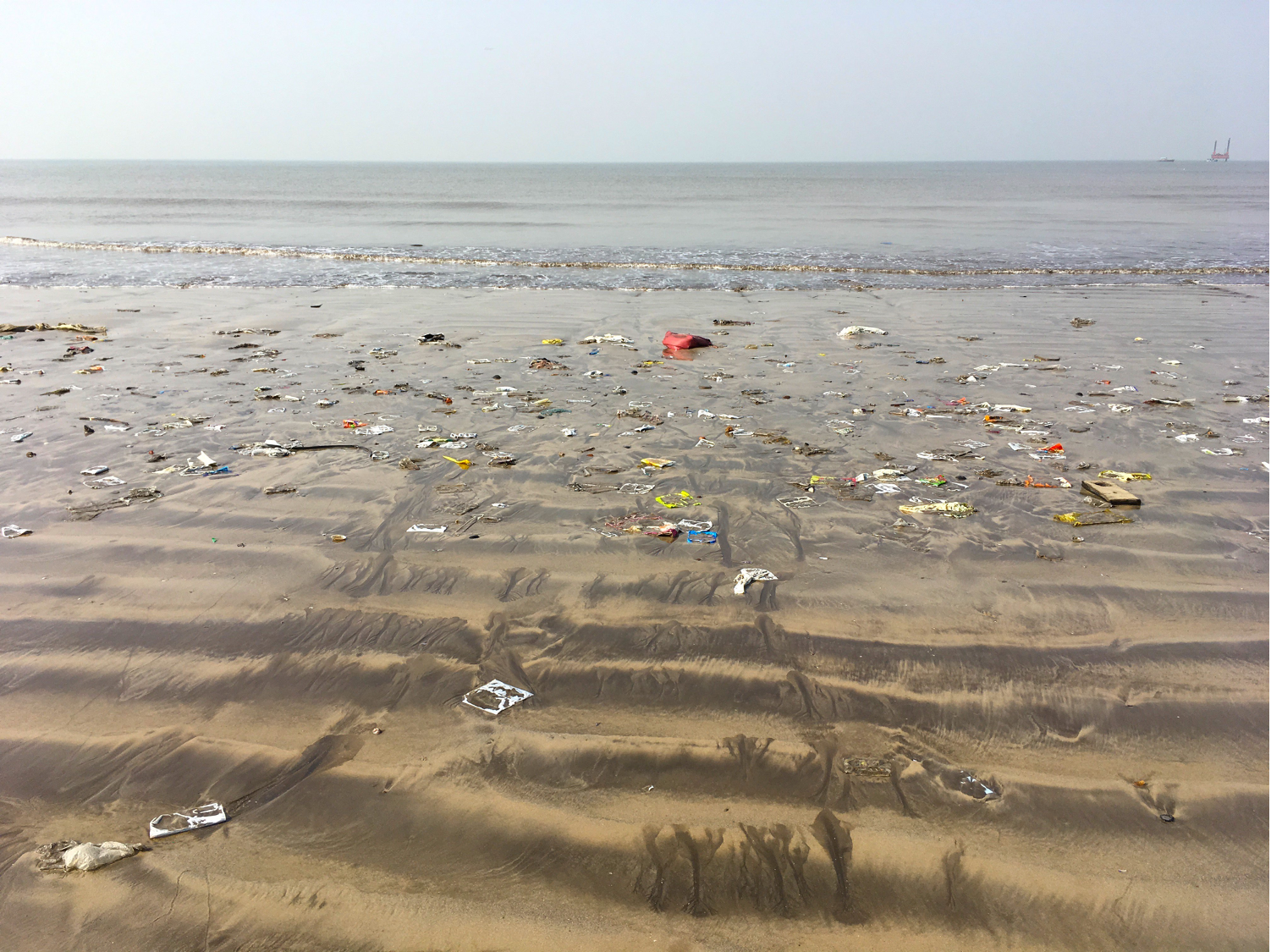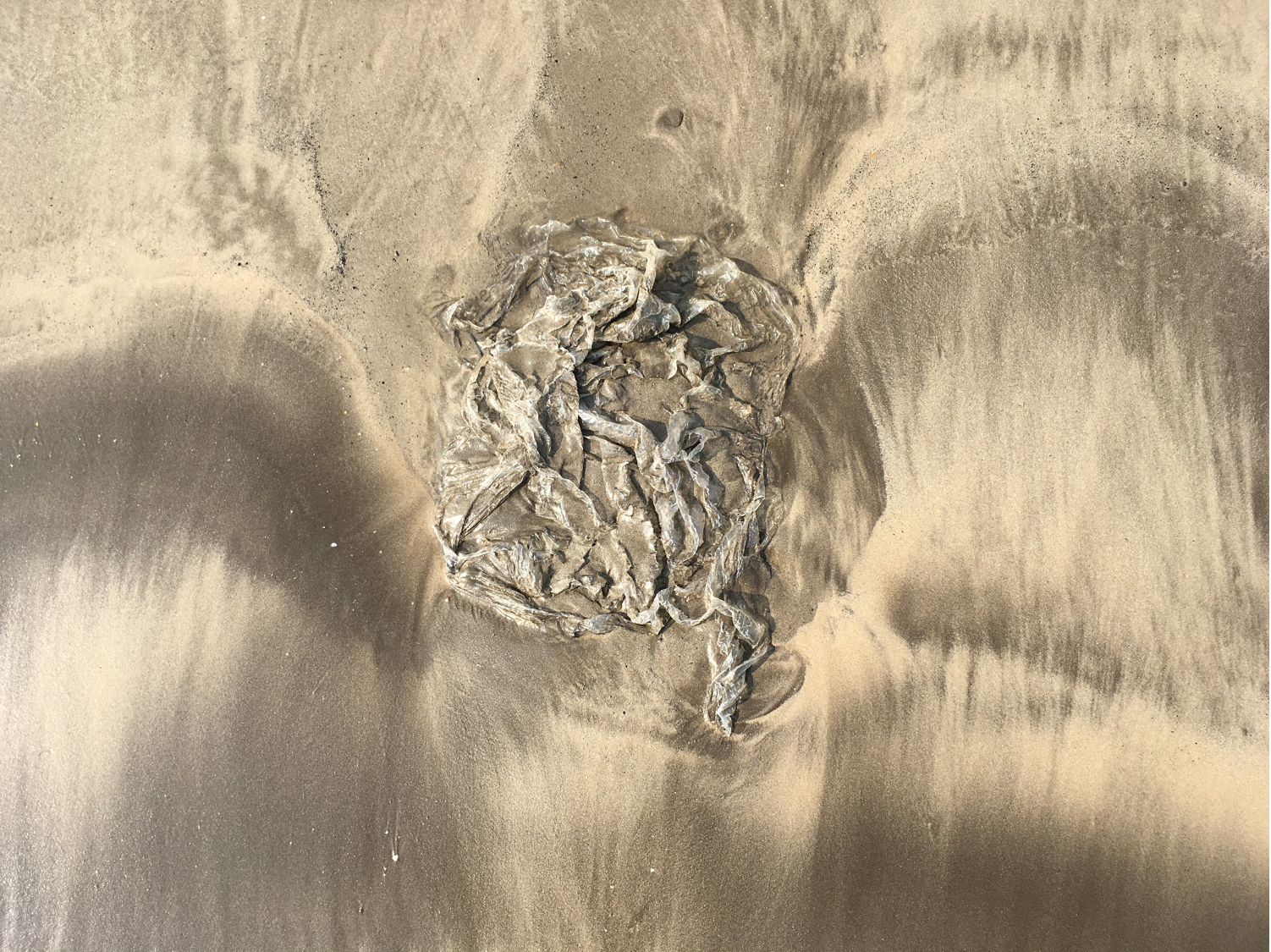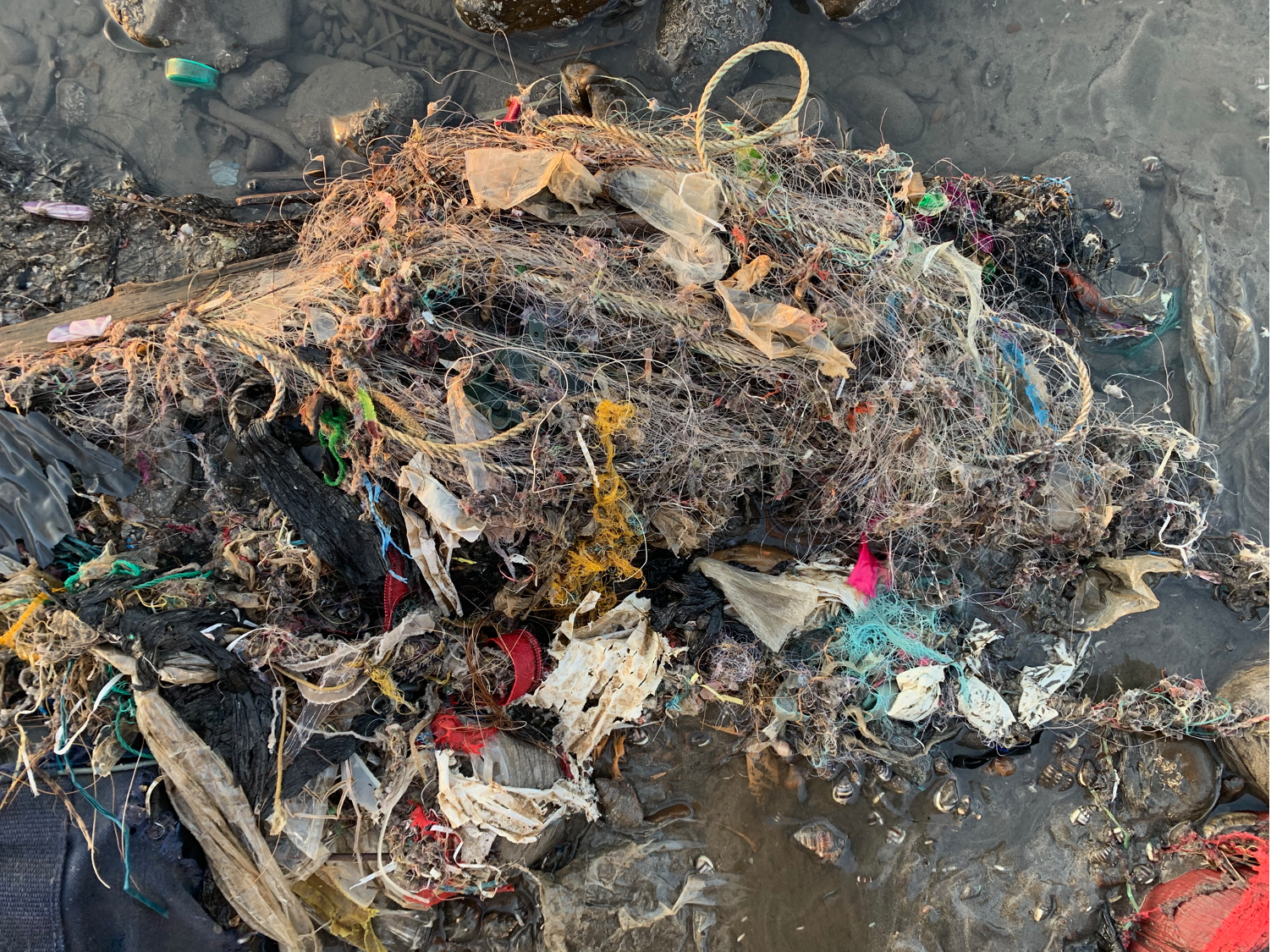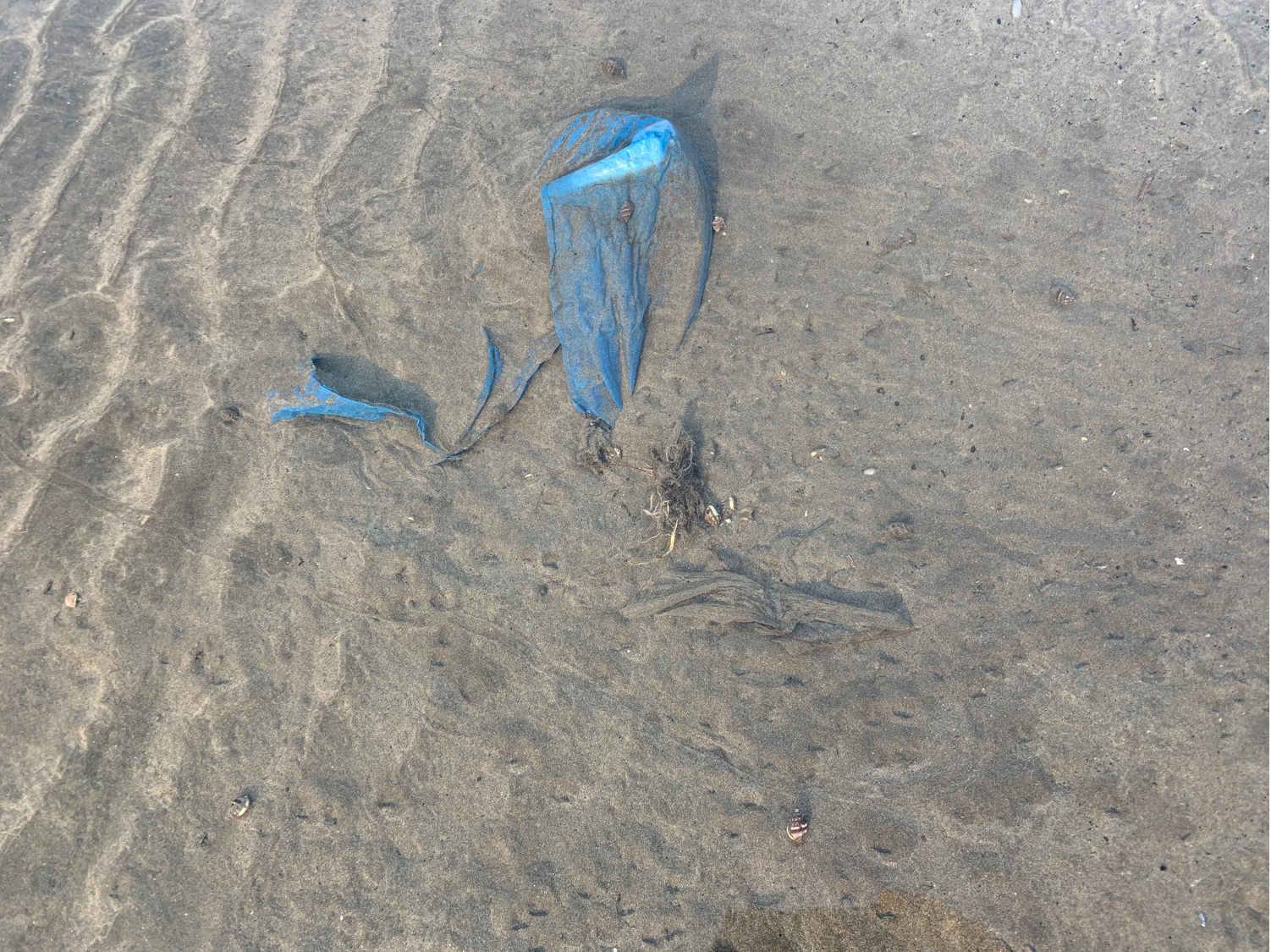
PlastiCity
Helen White + Ellie Kerns | Haverford College
Courtney Daub + Adwaita Banerjee | University of Pennsylvania
Siddharth Chitalia | School of Environment and Architecture
Zulekha Sayyed | CAMPAbstract
Seas, particularly in urban areas, are a gathering of many different elements: hydrogen, carbon and oxygen; water, earth and air. PlastiCity aims to write biographies of one particular figuration of these elements: plastic. What are the plastics that now form Mumbai’s urban sea? From where did they come? Where are they going? What do they bring to our understandings of the urban sea as ‘nature’? How is the petrochemical sea understood and inhabited by more-than-human others-- planners, fish, crabs and flamingoes? In this project we will figure the composition of plastic in Mumbai’s seas; learn where they are coming from and how they inhabit the sea; and describe how they produce new habitats for plants, animals and humans in the Anthropocene.
Project Note
Every year during the monsoon, the Arabian sea returns heaps of plastic to the city’s shores. The sandy bottles and bags, ignited methane and smoke from plastic tides, landfill fires and other events which move waste through the shared water and air of the city, have garnered widespread attention around the crisis of waste. Keeping in mind this urgency, in this collection of media we move beyond the crisis of waste in general to think with small moments of the diverse circulations and makings of plastics in Mumbai— their sites of discard, accumulation, and (non-)collection.
Composition












As the tide recedes the intertidal zone is revealed. Stretches of coastline, sandy beaches, rocks, and marine life appear from beneath the water. No longer submerged, these once hidden habitats can be temporarily seen and examined.
The movement of water across the shorelines of Mumbai also reveals a human contribution to the intertidal zone. Piles of discarded debris comprised mostly of plastic and fabric become visible. These materials are trapped: buried by sand; caught in rocks and other debris (photo 4); intermingled with intertidal inhabitants; and in some instances, incorporated into the marine life itself.
By collecting and examining plastics we are able to determine the types of plastic that are present, and in turn attempt to understand where they come from and why they are a part of the intertidal zone.
The plastic samples collected from Mumbai shorelines are comprised primarily of Polyvinyl Chloride (PVC; 40%) followed by roughly equal amounts of Polyethylene Terephthalate (PET; 17%), Polystyrene (PS; 16%) and Polypropylene (PP; 15%). A few pieces of High-Density Polyethylene (HDPE; 6%), Low-Density Polyethylene (LDPE; 2%), and other forms of plastic such as Polyvinyl Acetate (PVA; 1%), acetal (1%) and silicon (1%) are also found.
Some plastic samples are recognizable and even traceable to their original forms: a pill packet, pen lid, drinking straw, cassette tape, hair comb, plastic bag, nail clipper, candy wrappers. Other plastic samples are unidentifiable and may contain other materials in addition to plastic, as is the case for multilayered plastics.
Taking this chemical profile of the shore’s plastic discard as a point of provocation, here we trace some of the many materialities of plastic as they matter and are known by the labors of circulation and by logics of cost-efficacy and capital accumulation.
Exchange
Garlic for Plastic| Deonar | 2020
Before reaching the dumping ground, returning to the city’s shores or being caught elsewhere, various kinds of plastics are rerouted from and through a diverse set of sites and relations. People that collect plastic negotiate and create networks in order to access different areas of the city, each with different quantities and qualities of plastic.
In wealthier and higher-producing areas of the city which often receive waste pick-up services, plastics go through many hands as they travel between private and public spaces; many are sold directly from households to bhangarwalas with larger carts or otherwise collected by municipal employees, domestic workers and ragpickers.Smaller-scale collections also exist in areas producing fewer plastics and which are not serviced by the municipal corporation in waste collection.
In Sathe Nagar Vimal Khillare buys garlic from the market to exchange for plastics segregated by mostly women in households in the morning before her second job working in a cake factory. She sells her assortment of oil, yogurt and cleaning containers, water bottles and sandals— bulkier, materially simple and relatively clean plastics— at a kilo-rate to a scrap dealer. Through her extra plastics income she has been able to support herself and her children as a single mother. What plastic escapes these exchanges?
Metamorphosis
The Business of Segregation | Mankhurd | 2020
After collectors — garlic sellers, bhangarwalas and garbage truck drivers among them— gather their plastics and other recyclables, they are often sold to scrap dealers, in whose shops and spaces plastic is further segregated and stored before they are sold to larger dealers or recyclers. While some scrap dealers specialize in a particular form of plastic— PET bottles or remote controls received directly from companies for example— Dilip Chavan receives and sells a diverse number of plastics by the kilo. These plastics are often known less by their chemical composition, such as PET or PVC, and more by how they feel (soft or hard), sound or by their common commodity form (chappal).
Transformation
Aakar Mumbai's recycling operation| Goregaon | 2020
NGOs across the city have changed and redirected the composition and destination of plastic flows in the areas in which they operate. One such NGO, Aakar Mumbai, began working with women who pick plastic waste from garbage bins along the western line in 2004. They partnered with the BMC to coordinate the arrival of municipal trucks, so that the women pickers could take plastic from bins before they are transported elsewhere or collected by municipal employees.
In 2014 with support from the United Nations Development Programme and Hindustan Unilever the BMC set up dry-waste segregation centers to be run by Aakar Mumbai. With this infrastructure, they collect pre-segregated dry waste from mostly already-serviced households and societies with bins. The few segregation centers set up are the “pilot” portion of a larger vision by the UNDP, which is working to develop Extended Producer Responsibility guidelines to scale these projects.
The waste centers have also changed local supply chains. Aakar Mumbai sells plastic directly to larger vendors and waste pickers also sell directly to Aakar Mumbai rather than small-scale scrap dealers. Many of the plastics they collect from bins are by other means of collection considered low-value either because of their light-weight and/or compositional complexity. These plastics they send to cement companies. What kinds of plastic collection are enabled by the scale of recycling bins, trucks and segregation centers? What kinds of plastic collection are enabled by the scale of recycling bins, trucks and segregation centers and the organizations of labor they entail?
Blockage
Nala | Poisar | 2020
Nalas and other water bodies in Mumbai have long acted as sites of disposal and drainage for excess and waste: water, sewage and plastic. Like formal dumping grounds in the city, these sites are also important points for the collection of stray plastics of value. Collectors in the nala skip over the light-weight bags and packaging— which accumulate mud and make up the bulk of the nala’s plastic— to add the occasional PET bottle to their sack.
In one settlement situated by a nala that drains into the Poisar river, a system of service provision exists, but residents are obligated to pay a fee for door-to-door collection by the contractor in absence of a nearby community bin and to supplement the low wages of the collectors. Households likely unable to pay this fee instead dispose of their waste in the nala.
Disposal of plastics not otherwise sold by households into nalas by nearby settlements is common for areas without disposal infrastructure. As the collector, Kiran, explains, collection often stops altogether during the monsoon as floods take or damage their belongings and as collectors spend their time unclogging drains.
Accumulation
Shore Maintenance | Mahim | 2020
While nalas act as sites of disposal and collection, plastics moving through them during the monsoon have also been subject to efforts to reroute plastics into processes of production. Activism over the presence of plastic on shores through voluntary beach clean-ups has led to the contracting of disposal companies. One such company, Via Green, collects all the plastics that wash on shore. Many plastics that are normally not picked up in smaller scale collections— light-weight bags, wrappers and multi-layered packaging that require a lot of effort to collect to a profitable weight or which are not possible to mechanically recycle— accumulate in larger amounts on the shore. The sea in turn is used to wash the plastics to remove sand and other “impurities” that disrupt burning enterprises and which otherwise cost more to clean. These diverse types of plastics can be recycled together in Waste-to-Energy arrangements rather than segregated by chemical type for mechanical recycling and are sent to Nashik to be converted to oil.

Segregation of plastics based on their chemical properties at Katawala | Malad Link Road

Cluster of scrap dealers involved in the segregation and grinding process | Ekta Nagar, Malad

Piles of mixed plastic waste outside a scrap dealer’s workshop | Ganesh Nagar, Malad

Labourer removing labels & caps from all the plastic bottles before grinding them | Ganesh Nagar, Malad

Multi-layer packaging at the scrap dealer’s dumping ground | Malad Dumping ground

A dumping ground for recycling scrap situated in a wetland | Malad Dumping ground

Micro plastics in the open drains | Poisar, Kandivali

High retaining walls of the nallah | Indira Nagar, Govandi

Children picking plastic waste in the nallah | Indira Nagar, Govandi

The Link Road & Metro line, under construction, passing over the Poisar nallah | Malad Link Road

Labourers of contractor, appointed by BMC, cleaning the beach | Juhu Beach

Tractor- pulled beach cleaner | Juhu Beach

Student volunteering for beach clean-up drive | Juhu Beach
Watch Helen White introduce PlastiCity during our third seminar, Intertidal PlastiCity here:






